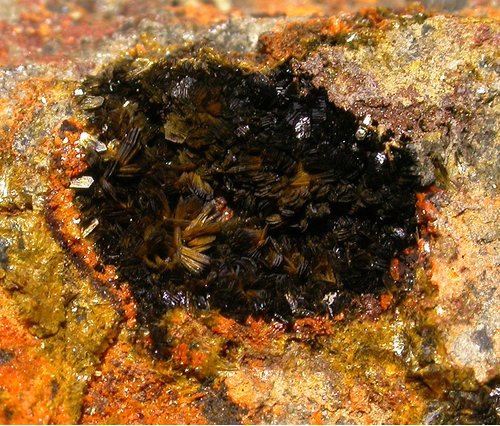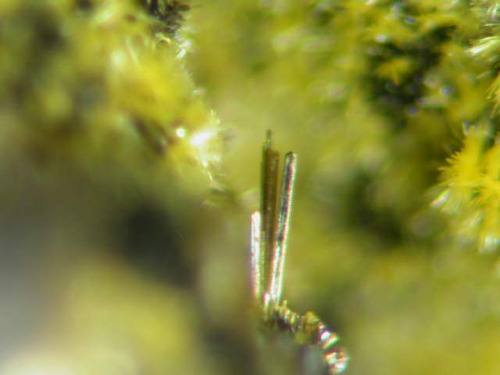Wyartite
A valid IMA mineral species
This page is currently not sponsored. Click here to sponsor this page.
About Wyartite
Formula:
CaU5+(UO2)2(CO3)O4(OH) · 7H2O
Colour:
Black, violet-black (fresh); yellowish brown, greenish brown (exposed)
Lustre:
Vitreous, Sub-Metallic, Dull
Hardness:
3 - 4
Specific Gravity:
4.69
Crystal System:
Orthorhombic
Name:
Named after Jean Wyart (16 October 1902, Avion, Pas-de-Calais, France - 13 March 1992, Paris, France), Professor of Mineralogy, Sorbonne, Paris, France. He was an early researcher in the study of X-ray crystallography and was the first person to convert obsidian to granite under high pressure and temperature, demonstrating the importance of water in eruptive rocks. He also served as president of the International Union of Crystallography. [Obituary: http://journals.iucr.org/a/issues/1992/04/00/es0175/es0175.pdf]
Wyartite is unique in being the first recognized mineral with pentavalent uranium, beside containing typical hexavalent one in the form of uranyl groups. The other minerals sharing this feature are richetite, shinkolobweite, and nollmotzite.
The structure contains sheets that are similar to those found in ianthinite, rameauite, and spriggite.
The structure contains sheets that are similar to those found in ianthinite, rameauite, and spriggite.
Unique Identifiers
Mindat ID:
4319
Long-form identifier:
mindat:1:1:4319:5
GUID
(UUID V4):
(UUID V4):
cc83fa88-b850-4857-b33e-a9ddfb7a28f0
IMA Classification of Wyartite
Approved
First published:
1959
Classification of Wyartite
5.EA.15
5 : CARBONATES (NITRATES)
E : Uranyl Carbonates
A : UO2:CO3 > 1:1
5 : CARBONATES (NITRATES)
E : Uranyl Carbonates
A : UO2:CO3 > 1:1
16b.7.4.1
16b : HYDRATED CARBONATES CONTAINING HYDROXYL OR HALOGEN
7 : Miscellaneous
16b : HYDRATED CARBONATES CONTAINING HYDROXYL OR HALOGEN
7 : Miscellaneous
11.11.8
11 : Carbonates
11 : Carbonates of Cr and U
11 : Carbonates
11 : Carbonates of Cr and U
Mineral Symbols
As of 2021 there are now IMA–CNMNC approved mineral symbols (abbreviations) for each mineral species, useful for tables and diagrams.
| Symbol | Source | Reference |
|---|---|---|
| Wya | IMA–CNMNC | Warr, L.N. (2021). IMA–CNMNC approved mineral symbols. Mineralogical Magazine, 85(3), 291-320. doi:10.1180/mgm.2021.43 |
Physical Properties of Wyartite
Vitreous, Sub-Metallic, Dull
Transparency:
Transparent, Translucent, Opaque
Comment:
Luster dull, on cleavage vitreous to sub-metallic
Colour:
Black, violet-black (fresh); yellowish brown, greenish brown (exposed)
Comment:
Wyartite is somewhat photosensitive and may change from nearly black when exposed to light to dark brown to brownish-orange. Crystals end frequently brighten ahead of the crystal shafts.
Streak:
brownish-violet
Hardness:
3 - 4 on Mohs scale
Cleavage:
Perfect
(001) perfect, also (010)
(001) perfect, also (010)
Density:
4.69(5) g/cm3 (Measured)
Optical Data of Wyartite
Type:
Biaxial (-)
RI values:
nα = 1.890(2) nβ = 1.890(2) nγ = 1.910(2)
2V:
Measured: 48°
Max Birefringence:
δ = 0.020

Image shows birefringence interference colour range (at 30µm thickness)
and does not take into account mineral colouration.
and does not take into account mineral colouration.
Surface Relief:
Very High
Dispersion:
strong
Pleochroism:
Strong
Comments:
X (=c) gray, Y (=b) violet, Z (=a) (lavender blue) .
Chemistry of Wyartite
Mindat Formula:
CaU5+(UO2)2(CO3)O4(OH) · 7H2O
Crystallography of Wyartite
Crystal System:
Orthorhombic
Class (H-M):
2 2 2 - Disphenoidal
Space Group:
P21 21 21
Cell Parameters:
a = 11.25(3) Å, b = 7.08(2) Å, c = 20.98(5) Å
Ratio:
a:b:c = 1.589 : 1 : 2.963
Unit Cell V:
1,671.06 ų (Calculated from Unit Cell)
Z:
4
Comment:
Point Group: 2/m 2/m 2/m?
Crystal Structure
Load
Unit Cell | Unit Cell Packed
2x2x2 | 3x3x3 | 4x4x4
Unit Cell | Unit Cell Packed
2x2x2 | 3x3x3 | 4x4x4
Show
Big Balls | Small Balls | Just Balls | Spacefill
Polyhedra Off | Si Polyhedra | All Polyhedra
Remove metal-metal sticks
Big Balls | Small Balls | Just Balls | Spacefill
Polyhedra Off | Si Polyhedra | All Polyhedra
Remove metal-metal sticks
Display Options
Black Background | White Background
Perspective On | Perspective Off
2D | Stereo | Red-Blue | Red-Cyan
Black Background | White Background
Perspective On | Perspective Off
2D | Stereo | Red-Blue | Red-Cyan
View
CIF File Best | x | y | z | a | b | c
CIF File Best | x | y | z | a | b | c
Rotation
Stop | Start
Stop | Start
Labels
Console Off | On | Grey | Yellow
Console Off | On | Grey | Yellow
Data courtesy of the American Mineralogist Crystal Structure Database. Click on an AMCSD ID to view structure
| ID | Species | Reference | Link | Year | Locality | Pressure (GPa) | Temp (K) |
|---|---|---|---|---|---|---|---|
| 0002316 | Wyartite | Burns P C, Finch R J (1999) Wyartite: Crystallographic evidence for the first pentavalent-uranium mineral American Mineralogist 84 1456-1460 |  | 1999 | 0 | 293 | |
| 0006129 | Wyartite | Hawthorne F C, Finch R J, Ewing R C (2006) The crystal structure of dehydrated wyartite, Ca(CO3)[U5+(U6+O2)2O4(OH)] (H2O)3 The Canadian Mineralogist 44 1379-1385 |  | 2006 | Shinkolobwe mine, Shaba, Democratic Republic of Congo | 0 | 293 |
CIF Raw Data - click here to close
X-Ray Powder Diffraction
Powder Diffraction Data:
| d-spacing | Intensity |
|---|---|
| 10.3 Å | (100) |
| 8.54 Å | (30) |
| 5.19 Å | (30) |
| 4.26 Å | (4b) |
| 3.55 Å | (4) |
| 7.64 Å | (3) |
| 4.72 Å | (3) |
Geological Environment
Paragenetic Mode(s):
| Paragenetic Mode | Earliest Age (Ga) |
|---|---|
| Stage 7: Great Oxidation Event | <2.4 |
| 47a : [Near-surface hydration of prior minerals] | |
| 47c : [Carbonates, phosphates, borates, nitrates] | |
| 47f : [Uranyl (U⁶⁺) minerals] |
Type Occurrence of Wyartite
General Appearance of Type Material:
In small crystals with (001) predominant, striated, and (110)
Place of Conservation of Type Material:
Royal Museum of Central Africa, Tervuren, Belgium, RMG2222; Natural History Museum, Paris, France, V 5686; National School of Mines, Paris, France; The Natural History Museum, London, England, 1969,47; National Museum of Natural History, Washington, D.C., USA, 150331.
Geological Setting of Type Material:
as an alteration product of a red alteration product of uraninite (wolsendorfite?)
Reference:
Guillemin, C., Protas, J. (1959) Ianthinite et wyartite. Bulletin de la Société française de Minéralogie et de Cristallographie: 82: 80-86.
Synonyms of Wyartite
Other Language Names for Wyartite
Common Associates
Associated Minerals Based on Photo Data:
| 5 photos of Wyartite associated with Curite | Pb3(H2O)2[(UO2)4O4(OH)3]2 |
| 4 photos of Wyartite associated with Schoepite | (UO2)8O2(OH)12 · 12H2O |
| 3 photos of Wyartite associated with Urancalcarite | Ca(UO2)3(CO3)(OH)6 · 3H2O |
| 1 photo of Wyartite associated with Uranophane | Ca(UO2)2(SiO3OH)2 · 5H2O |
| 1 photo of Wyartite associated with Becquerelite | Ca(UO2)6O4(OH)6 · 8H2O |
Related Minerals - Strunz-mindat Grouping
| 5.EA.05 | UM1997-24-CO:CaCuHU | Ca2Cu(UO2)2(CO3)2O3 · 3H2O |
| 5.EA.10 | Urancalcarite | Ca(UO2)3(CO3)(OH)6 · 3H2O |
| 5.EA.20 | Oswaldpeetersite | (UO2)2(CO3)(OH)2 · 4H2O |
| 5.EA.25 | Roubaultite | Cu2(UO2)3(CO3)2O2(OH)2 · 4H2O |
| 5.EA.30 | Kamotoite-(Y) | Y2(UO2)4(CO3)3O4 · 14H2O |
| 5.EA.35 | Sharpite | Ca(UO2)3(CO3)4 · 3H2O |
Other Information
Notes:
radioactive
Health Risks:
No information on health risks for this material has been entered into the database. You should always treat mineral specimens with care.
Internet Links for Wyartite
mindat.org URL:
https://www.mindat.org/min-4319.html
Please feel free to link to this page.
Please feel free to link to this page.
Search Engines:
External Links:
Mineral Dealers:
References for Wyartite
Reference List:
Burns, Peter C. (2005) U6+ minerals and inorganic compounds: insights into an expanded structural hierarchy of crystal structures. The Canadian Mineralogist, 43 (6) 1839-1894 doi:10.2113/gscanmin.43.6.1839
Localities for Wyartite
Locality List
 - This locality has map coordinates listed.
- This locality has map coordinates listed.
 - This locality has estimated coordinates.
ⓘ - Click for references and further information on this occurrence.
? - Indicates mineral may be doubtful at this locality.
- This locality has estimated coordinates.
ⓘ - Click for references and further information on this occurrence.
? - Indicates mineral may be doubtful at this locality.
 - Good crystals or important locality for species.
- Good crystals or important locality for species.
 - World class for species or very significant.
(TL) - Type Locality for a valid mineral species.
(FRL) - First Recorded Locality for everything else (eg varieties).
- World class for species or very significant.
(TL) - Type Locality for a valid mineral species.
(FRL) - First Recorded Locality for everything else (eg varieties).
All localities listed without proper references should be considered as questionable.
Australia | |
| R.L. Frost et al. (4) |
| R.L. Frost et al. (4) | |
DR Congo (TL) | |
| 304 [288]. +3 other references |
France | |
| - (1998) |
| J.-J. Périchaud: "Où trouver les minéraux d'Auvergne" et al. (Clermont-Ferrand) | |
India | |
| Yadav et al. (2008) |
| Yadav et al. (2008) | |
Jordan | |
| Dill et al. (2009) |
Quick NavTopAbout WyartiteUnique IdentifiersIMA Classification Classification Mineral SymbolsPhysical Properties Optical Data Chemistry Crystallography Crystal StructureX-Ray Powder DiffractionGeological EnvironmentType Occurrence SynonymsOther LanguagesCommon AssociatesStrunz-MindatOther InformationInternet Links References Localities Locality List







 symbol to view information about a locality.
The
symbol to view information about a locality.
The 




Shinkolobwe Mine, Shinkolobwe, Kambove Territory, Haut-Katanga, DR Congo